#kamakura period
Photo
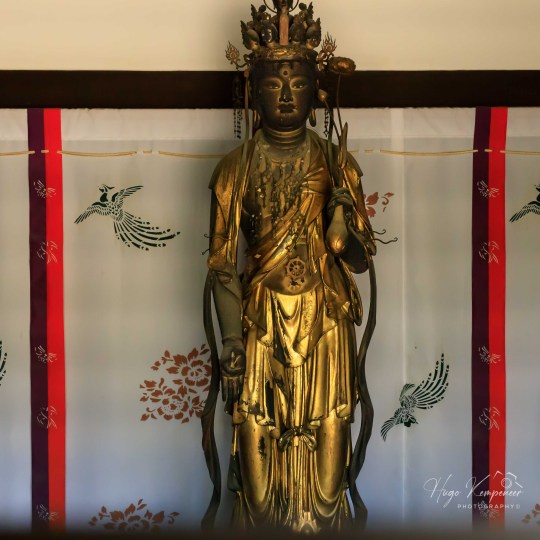
Several scenes of the temple grounds of Shin-Yakushi-ji in Nara, Japan.
#Buddhism#Empress Kōmyō#Japan#Kamakura period#Nara#Shin-Yakushi-ji#Shin-Yakushiji#Twelve Divine Generals#Yakushi Nyorai#travel#光明皇后#十二神将#新薬師寺#薬師如来#鎌倉時代
29 notes
·
View notes
Photo

Yabusame – Female Horse Archer at Meiji Shrine by Tokyobling's Blog
“This year’s Yabusame at Meiji Shrine was slightly unusual due to the high number of very talented female archers. You could tell from the excited reactions of the audience when they were being introduced that female archers make a wildly popular sport even more popular!”
Yabusame is considered a symbolic event for Kamakura Period during which the first Samurai rule of Shogunate was established in Kamakura. It was also the period known for many female warriors such as Tomoe Gozen and Hojo Masako, known for their horse riding and archery skills.
#yabusame#horse archery#mounted archery#female warrior#female archer#japan#japanese culture#japanese tradition#meiji shrine#japanese archery#kamakura period#kamakura shogunate#samurai#female samurai#onna bugeisha#onna musha#tomoe gozen#hojo masako#tokyobling blog
356 notes
·
View notes
Text
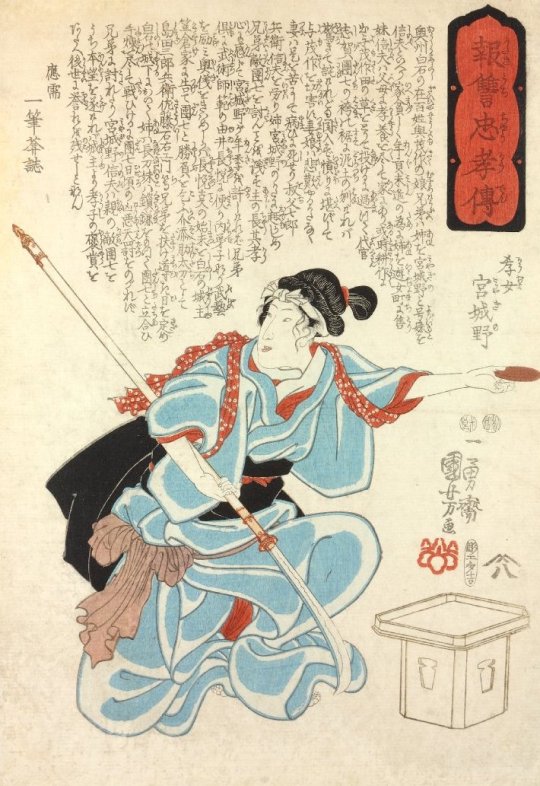
KOJO MIYAGINO: The Filial Using a Naginata (mid 1800s). Woodblock print, oban tate-e. 36.90cm x 25.40cm. British Museum.
What comes to mind when you hear the word samurai? Men wielding katanas? Ironclad Japanese warriors about to strike a blow? Or perhaps a robed samurai on the verge of self-sacrifice.
How about a kimono-wrapped lady on the verge of kicking ass?
While most women in feudal Japan were expected to adhere to traditional roles, samurai as a rising warrior class (actually called “bushi” before the Kamakura Period) included both men and women. However, "samurai" was a term reserved for men. Women "samurai" were deemed onna-musha (a female warrior on the offensive) or onna bugeisha, a warrior woman on the defensive.
Onna musha were rarer than their onna bugeisha counterparts, who were nevertheless formidable women. Onna bugeisha were trained in martial arts to defend their homes against the frequent ransacking that took place during the Warring States Period in feudal Japan. Their weapon of choice was the naginata, a curved sword mounted on a pole, first used by warrior monks in 750 A.D.
#onna musha#onna bugeisha#female samurai#japanese warrior women#warrior women#kamakura period#naginata#samurai#japanese history
10 notes
·
View notes
Text
The Heian period (794-1185), known for its aristocratic culture, witnessed court women flourishing in literary circles. A number of classic masterpieces were created by Ono no Komachi, Izumi Shikibu, Seisho Nagon, and Murasaki Shikibu, to name but a few. Their works are widely read and studied to this day, among which the most legendary is Genji Monogatari (The Tale of Genji) by Murasaki Shikibu.
In the late Heian period (794-1185), Buddhist and Shinto beliefs that associated women with impurity and sinfulness became widespread.
During the Kamakura period (1185-1333) when the samurai took over the aristocrats, the notion of “men superior, women inferior (danson johi)” that was based on these religious beliefs had developed, particularly larly in the privileged samurai class.
This notion to hold women in subjugation jugation to men prevailed mainly among the upper and ruling samurai class in the Edo period (1603-1867). In contrast to women of the samurai class whose roles were mostly limited to producing male heirs, women of the middle and lower working class of farmers, artisans, and merchants, chants, still enjoyed autonomy to some extent (Kaneko, 1995; Okano, 1995).
However, the notion of “men superior, women inferior (danson johi)” permeated all social classes during the Meiji period (1868-1912), when the Civil Code of 1898 legitimized the ie (family, household) system tem that was based on the family system of the samurai class between the Kamakura period (1185-1333) and the Edo period (1603-1867). Under the ie system, the eldest son typically became the head of the family, and not only inherited the property to maintain the lineage, but also exercised absolute authority over family members.
#book : women in the language and society of japan#japan#misoginy#heian period#ono no komachi#izumi shikibu#seisho nagon#murasaki shikibu#buddhism#shinto#kamakura period#samurai#misogyny#culture#edo period#meiji period#politics
16 notes
·
View notes
Text
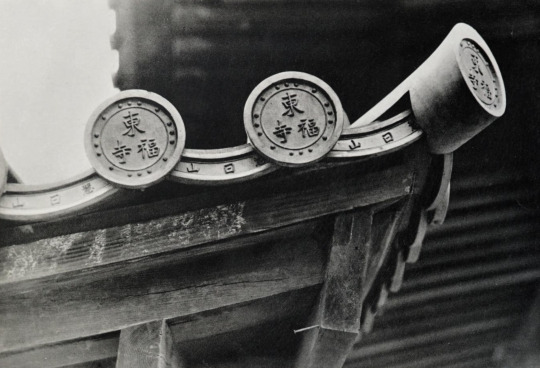
Tile roof of the Tōfuku-ji Temple, Kamakura period (1236). Tōfuku-ji, Kyoto, Kyoto Prefecture.
"Of these ornamental terminal tiles, one is decorated with the three characters of the name of the monastery, Tō-Fuku-ji, and the other with the monastery's sacred name, E-Nichi-Zan."
From "Japan: Art and Civilization" by Louis Frederic, published in 1971.
11 notes
·
View notes
Photo

Day 10: Lady Nijo!
Lady Nijo (as with almost all aristocratic women of her era, Nijo was a nickname, in her case “Second Avenue,” part of a contemporary trend in which the location of the street indicated social rank) was born into a high-ranking aristocratic family in Kamakura period Japan. Her father held a high position at court, and the Emperor had been one-sidedly in love with her mother; Lady Nijo herself was raised at court, and eventually became a concubine to Emperor Go-Fukakusa.
Her father’s death weakened her position politically, and she had an up-and-down relationship with the Emperor. It says something about the culture of the court at the time that Go-Fukakusa raised no objection to her three illegitimate children; rather, it was the Empress who protested Lady Nijo’s unsuitability as a concubine (and, possibly, the Emperor’s continued affection for her), and it was at her behest that Lady Nijo was relieved of her position at court.
Lady Nijo took vows as a Buddhist nun, and spent much of the rest of her life traveling. She traced the journeys of Saigyo, a poet of the previous century, and devoted time to her own literary efforts as well.
Her autobiography, Towazugatari, anglicized as The Confessions of Lady Nijo, was completed in 1307. It was nearly lost during the centuries that followed, but its rediscovery in the mid-twentieth century brought Lady Nijo back to the literary forefront; today, Towazugatari is considered one of the classics of Japanese literature.
#lady nijo#history#japanese history#kamakura period#awesome ladies of history#october 2022#towazugatari#my art
41 notes
·
View notes
Text
Yo.... Totally random and not at all related to my Hazbin Hotel OC question here 👀.
Does anybody have any recommendations for a website or links to places where I could find some good references for Kamakura Period menswear? More specifically for warriors/warrior families? I can find articles on the history, but it is a bit difficult to find good pictures of the clothing (at least, with how I'm looking it up. I may just be trash at searching for it lol). Please and thank you!
#oc creation#Kamakura Period#japanese culture#japanese clothing#History#japanese history#please help if you can
6 notes
·
View notes
Text

Japanese taishotoku bugaku mask (wood with polychromy). Artist unknown; 13th century (Kamakura period). Now in the Tokyo National Museum.
#art#art history#Asian art#Japan#Japanese art#East Asia#East Asian art#Kamakura period#Medieval Japan#Feudal Japan#mask#masks#woodwork#carving#13th century art#Tokyo National Museum
45 notes
·
View notes
Text

Bodhisattva Cintāmaṇicakra, 13th century
Kenji 1, Kamakura period, Japan
Wood, joined block construction
Height 32.7 cm
This statue was carved from a cypress wood (hinoki) which was dyed in a red color to imitate sandalwood. The robe was decorated with cut gold leaf. The influence of Chinese Song dynasty can be seen on a decorative hair style and a draping robe. This statue was originally the principal image of Zōkezō-in in Shitennō-ji Temple, Osaka Prefecture. The various objects including sutra were deposited in the hollow of the statue.
Collection of the Nara National Museum
#Avalokitesvara#Buddhism#bodhisattva#figure#religion#cintamani#cintamanicakra#13th century#Kamakura period#Japanese#bodisattva#sculpture#wood#cypress#gilding#gold#art#art history#Nara National Museum#iconography
5 notes
·
View notes
Text
Yoshida Kenko gets welcomed in Iran
It’s a real Good one when the writings of Shinto,Japanese monk Yoshida Kenko* get officially licenced in Iran.See: https://www.tehrantimes.com/news/478393/Tsurezuregusa-of-Kenko-published-in-Persian *He lived between Muromachi and Kamakura period.
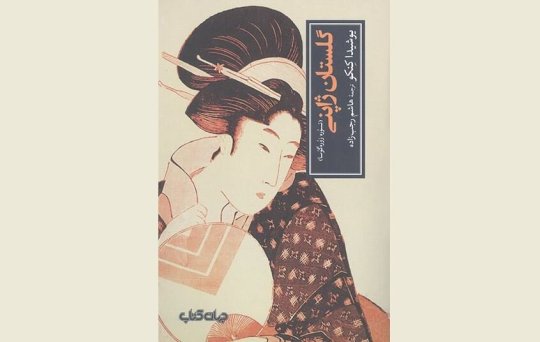
“Tsurezuregusa of Kenko” published in Persian
Jahan-e Ketab is the publisher of the book, which has been compared to the Gulistan (The Rose Garden), Persian poet Sadi’s masterpiece. It has been translated into Persian by Hashem Rajabzadeh.
Despite the turbulent times in which he lived, the Buddhist priest Kenko met the world with a measured eye.
As Emperor Go-Daigo fended off a challenge from the usurping Hojo family, and Japan stood at the brink of a dark political era, Kenko held fast to his Buddhist beliefs and took refuge in the pleasures of solitude.

Written between 1330 and 1332, “Essays in Idleness” reflects the congenial priest’s thoughts on a variety of subjects.
His brief writings, some no more than a few sentences long and ranging in focus from politics and ethics to nature and mythology, mark the crystallization of a distinct Japanese principle: that beauty is to be celebrated, though it will ultimately perish.
Through his appreciation of the world around him and his keen understanding of historical events, Kenko conveys the essence of Buddhist philosophy and its subtle teachings for all readers.
Insisting on the uncertainty of this world, Kenko asks that we waste no time in following the way of Buddha.
An English translation by Donald Keene was published in 1998. This critically acclaimed translation is joined by a new preface, in which Keene himself looks back at the ripples created by Kenko’s musings, especially for modern readers.
“Essays in Idleness: The Tsurezuregusa of Kenko” is his most famous work was and is one of the most studied works of medieval Japanese literature.
Kenko (1283?–1350?) was a Japanese author and Buddhist monk. He wrote during the Muromachi and Kamakura periods.
Photo: Front cover of the Persian edition of Yoshida Kenko’s “Essays in Idleness: The Tsurezuregusa of Kenko”.
#Essays in Idleness: The Tsurezuregusa of Kenko#兼好#Yoshida Kenkō#culture#Iran-Japan ties#1283–1350#Muromachi period#室町時代#Ashikaga era#Emperor Go-Daigo#後醍醐天皇#Kamakura period#鎌倉時代#Shōgun#Minamoto no Yoritomo#源 頼朝#Tehrantimes
1 note
·
View note
Text

Lady Hangaku (Hangaku Gozen), by Yoshitoshi.
She took a prominent role in the Kennin Rebellion, an uprising against the Kamakura shogunate in 1201.
#Onna-musha#female warriors#Female warrior#Japan#Yoshitoshi#Lady Hangaku#Hangaku Gozen#Kamakura period#Heian period#Hangaku Jo#Horse#Japanese history
0 notes
Photo

Several scenes of the temple grounds of Shin-Yakushi-ji in Nara, Japan.
#Buddhism#Empress Kōmyō#Japan#Kamakura period#Nara#Shin-Yakushi-ji#Shin-Yakushiji#Twelve Divine Generals#Yakushi Nyorai#travel#光明皇后#十二神将#新薬師寺#薬師如来#鎌倉時代
28 notes
·
View notes
Text

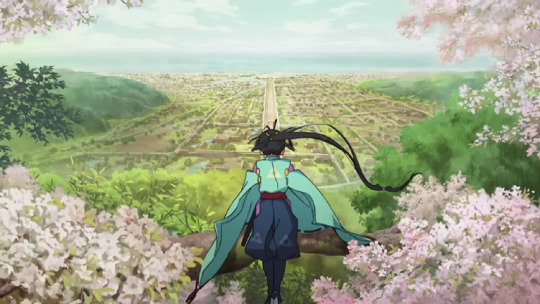


The Elusive Samurai (July 2024)
Set during the late Kamakura period, which follows the tale of Hojo Tokiyuki, a boy on the run after his family is overthrown by Ashikaga Takauji. With his only allies being a shady priest and his followers, the young lord must seek revenge and regain his glory, with his only weapon: a superhuman ability to flee and hide.
youtube
#the elusive samurai#Nige Jouzu no Wakagimi#hojo tokiyuki#ashikaga takauji#kamakura period#anime#japan#jidaigeki#historical anime#2024 anime
7 notes
·
View notes
Text

1 note
·
View note
Text
Japan
Japan is a fascinating country that has a rich history, culture, and society. It is an archipelago located in the Pacific Ocean, comprising of four main islands and several smaller ones. Japan has a population of over 126 million people, making it the world’s 11th most populous country. The country has a unique identity that has been shaped by its geography, history, culture, and economy. This…

View On WordPress
#Azuchi-Momyama Period#Edo Period#Heian Period#Heisei Period#Jomon Period#Kamakura Period#Kofun Period#Meiji Period#Muromachi Period#Nara Period#Showa Period#Taisho Period#Yayoi Period
0 notes
Text
The Heian period (794-1185), known for its aristocratic culture, witnessed court women flourishing in literary circles. A number of classic masterpieces were created by Ono no Komachi, Izumi Shikibu, Seisho Nagon, and Murasaki Shikibu, to name but a few. Their works are widely read and studied to this day, among which the most legendary is Genji Monogatari (The Tale of Genji) by Murasaki Shikibu.
In the late Heian period (794-1185), Buddhist and Shinto beliefs that associated women with impurity and sinfulness became widespread. During the Kamakura period (1185-1333) when the samurai took over the aristocrats, the notion of “men superior, women inferior (danson johi)” that was based on these religious beliefs had developed, particularly in the privileged samurai class. This notion to hold women in subjugation jugation to men prevailed mainly among the upper and ruling samurai class in the Edo period (1603-1867). In contrast to women of the samurai class whose roles were mostly limited to producing male heirs, women of the middle and lower working class of farmers, artisans, and merchants, chants, still enjoyed autonomy to some extent (Kaneko, 1995; Okano, 1995).
However, the notion of “men superior, women inferior (danson johi)” permeated all social classes during the Meiji period (1868-1912), when the Civil Code of 1898 legitimized the ie (family, household) system tem that was based on the family system of the samurai class between the Kamakura period (1185-1333) and the Edo period (1603-1867). Under the ie system, the eldest son typically became the head of the family and not only inherited the property to maintain the lineage, but also exercised absolute authority over family members.
#book: women in the language and society of japan the linguistics roots of bias#misogyny#Japan#heian period#meiji period#edo period#kamakura period#samurai
0 notes